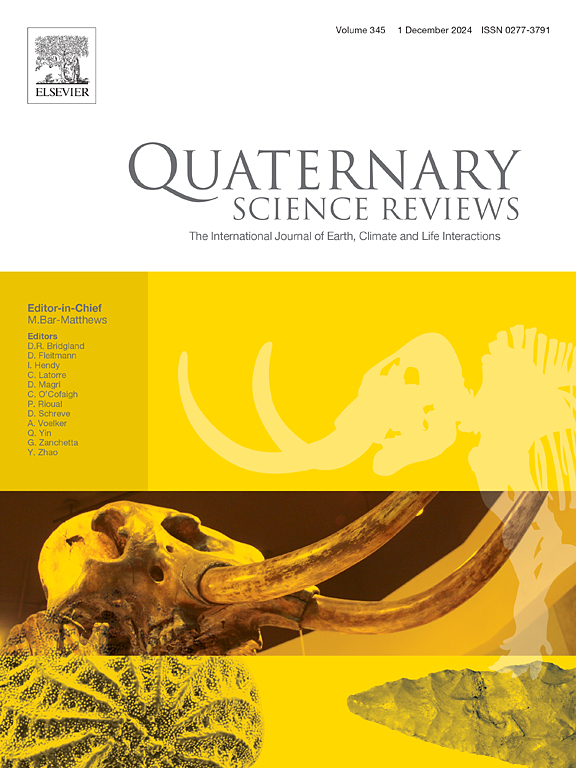中国西南海相同位素第9阶段的水文气候变率:来自多代石笋记录的启示
IF 3.2
1区 地球科学
Q1 GEOGRAPHY, PHYSICAL
引用次数: 0
摘要
作为当前间冰期的潜在模拟,海洋同位素阶段9 (MIS 9)可以帮助预测人为引起的温暖气候。然而,有限的关注和缺乏古气候档案限制了我们对这一时期亚洲夏季风(ASM)等大型气候系统的理解。为了更好地了解MIS 9的ASM变化,我们研究了中国西南水明洞的精确年代和高分辨率的多代理石笋记录(SMY-1)(跨度为333.4 ~ 268.1 kyr B.P.)。其δ18O随北纬高纬度日晒和半球间日晒梯度呈现3个温暖亚阶段(MIS 9a、9c和9e)和2个寒冷亚阶段(MIS 9b和9d),强调了轨道强迫和低纬度水文变化对ASM变化的关键作用。δ13C和微量元素比值(Mg/Ca、Sr/Ca和Ba/Ca)记录的区域水文气候条件在千年尺度上响应ASM强度。ASM降水增加导致土壤微生物活性和植被密度增加,减少了方解石降水的先验效应和水岩相互作用的持续时间。此外,我们还发现在MIS 9/8转变期间δ18O和微量元素比值的两步增加,与冰筏碎屑事件的两个脉冲和大西洋经向翻转环流的逐渐减弱相一致。mis9和mis3之间δ18O的相似变化模式,以及已确定的中国间冰期18-25,表明晚更新世气候周期中北大西洋普遍的千年尺度气候振荡通过海气重组影响了ASM的变化。有趣的是,SMY-1 δ18O在末次冰期前和MIS - 9e间冰期之间的变化幅度相对较低,这与中国其他石笋的发现相矛盾。这种空间异质性反映了区域尺度水分来源和同位素分馏过程对中国石笋δ18O记录的综合影响。本文章由计算机程序翻译,如有差异,请以英文原文为准。
Hydroclimate variability in southwest China during Marine Isotope Stage 9: Insights from multi–proxy stalagmite records
As a potential analogue of the present interglacial, the Marine Isotope Stage 9 (MIS 9) can help predict anthropogenically induced warm climates. However, limited attention and scarce paleoclimate archives have constrained our comprehension of large climate systems like the Asian summer monsoon (ASM) during this period. To better understand the ASM variability in MIS 9, we examined a precisely dated and highly resolved multi–proxy stalagmite record (SMY–1) (spanning from 333.4 to 268.1 kyr B.P.) from Shuiming Cave in southwest China. Its δ18O reveals three warm substages (MIS 9a, 9c, and 9e) and two cold substages (MIS 9b and 9d), following the high–northern–latitude insolation and interhemispheric insolation gradients, underscoring a key role of orbital forcing and low–latitude hydrological changes on ASM variabilities. Regional hydroclimate conditions recorded by its δ13C and trace element ratios (Mg/Ca, Sr/Ca, and Ba/Ca) respond to the ASM intensity on millennial scales. Increased ASM precipitation led to higher soil microbial activity and vegetation density, reducing the prior calcite precipitation effect and the water–rock interaction duration. Furthermore, we identified two–step increases in δ18O and trace element ratios during the MIS 9/8 transition, coinciding with two pulses of ice–rafted debris events and the gradual decline of the Atlantic meridional overturning circulation. Similar change patterns of δ18O between MIS 9 and MIS 3, alongside identified Chinese Interstadials 18–25, demonstrate that universal millennial–scale climate oscillations in the North Atlantic during Late Pleistocene climate cycles influenced variations in ASM via ocean–atmospheric reorganizations. Interestingly, the comparatively lower amplitude of SMY–1 δ18O variation between the antepenultimate deglaciation and the MIS 9e interglacial contradicts findings from other Chinese stalagmites. This spatial heterogeneity reflects the combined influence of regional–scale moisture sources and isotopic fractionation process along pathways on Chinese stalagmite δ18O records.
求助全文
通过发布文献求助,成功后即可免费获取论文全文。
去求助
来源期刊

Quaternary Science Reviews
地学-地球科学综合
CiteScore
7.50
自引率
15.00%
发文量
388
审稿时长
3 months
期刊介绍:
Quaternary Science Reviews caters for all aspects of Quaternary science, and includes, for example, geology, geomorphology, geography, archaeology, soil science, palaeobotany, palaeontology, palaeoclimatology and the full range of applicable dating methods. The dividing line between what constitutes the review paper and one which contains new original data is not easy to establish, so QSR also publishes papers with new data especially if these perform a review function. All the Quaternary sciences are changing rapidly and subject to re-evaluation as the pace of discovery quickens; thus the diverse but comprehensive role of Quaternary Science Reviews keeps readers abreast of the wider issues relating to new developments in the field.
 求助内容:
求助内容: 应助结果提醒方式:
应助结果提醒方式:


